At the beginning of the First World War
Russian Imperial army numbered 1 350 000 human, mobilization
razvёrnutыh to 5 338 000 human; at was armed 6848 lungs and 240 heavy
guns, 4157 pulyemyotov, 263 aircraft, over 4 thousand cars. For the first time in
history of Russia had to keep a continuous length of edge 900 kilometers and
depth to 750 kilometers and deploy an army of more than five million
human. The war demonstrated the many innovations: dogfights,
chemical weapon, first tanks, and "trench warfare", make useless
Russian cavalry. But the most important thing was, that the war is clearly
He demonstrated all the advantages of industrialized nations. Russian
empire, with its relatively undeveloped compared to Western Europe
industry, lacked arms, primarily because
called "slug hunger".
On
1914 year of the war was harvested all 7 million 5 thousand. shells. their reserves
in warehouses ended through 4-5 months of fighting; Russian
industry produced for the entire 1914 all year 656 thousand. shells (i.e
covering the needs of the army for one month). Already on the 53rd day of mobilization, 8
September 1914 Supreme Commander, Grand Duke Nicholas
It applies directly to the emperor: "For about two weeks there is
lack of artillery ammunition, I stated that it was to speed up
delivery. Now Adjutant General Ivanov brings, it shall suspend the
operations in the Przemysl and the entire front, while the cartridges are not brought in
local parks, at least up to one hundred per gun. Now there are only twenty
five. This forces me to ask Your Majesty to command speed delivery
cartridges ". Characteristically the answers of the War Ministry, headed by
Suhomlynovыm, that "too many troops shoot".
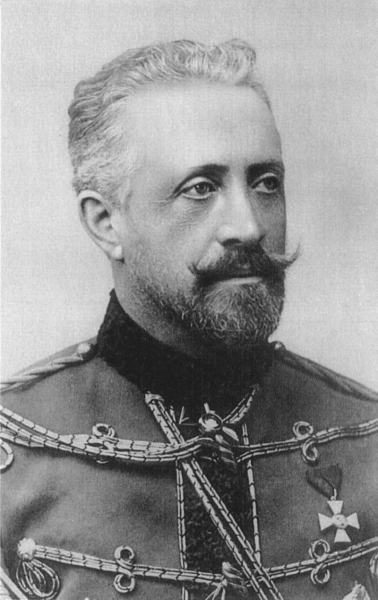
The Grand DukeNikolai
During 1915-1916 s sharpness
slug crisis has been reduced due to the increase of its own
production and imports; for 1915 year Russia produced 11 238 million shells, and
imported 1 317 million. In July 1915 , the empire passes to the mobilization of the home front,
formed a special meeting on national defense. Until that time, the government
traditionally tries to place military orders possible military
plants, not trusting the private. At the beginning 1916 Meeting two years nationalizes
the largest factory in Petrograd - Putilov and Obukhov. At the beginning 1917 of the year
slug crisis has been completely overcome, and artillery possessed even
excessive number of projectiles (3 thousand. easy to tool and 3 500 on heavy,
at 1 thousand. at the beginning of the war).
On
the end of the mobilization 1914 , there were all in the army 4,6 million
rifles at the size of the army itself in 5,3 million. Front requirements were
100-150 thousand. rifles on a monthly basis in the production of 1914 year only 27 thousand.
The situation could fix thanks to the mobilization of civil enterprises and
imports. Adopt modernized received maxim gun system
Mosin rifle sample 1910 of the year, new caliber guns 76-152 mm, Fedorov Avtomat.
relative
lack of development of railways (on 1913 year total duration of railways
in Russia than the US in 6 time) greatly hindered the rapid transfer of troops,
Logistics Army and major cities. The use of the railways in the first
all for the war effort considerably worsened the supply of bread in Petrograd and was
one of the causes of the February Revolution 1917 of the year (the beginning of the war the army took
third of the rolling stock).
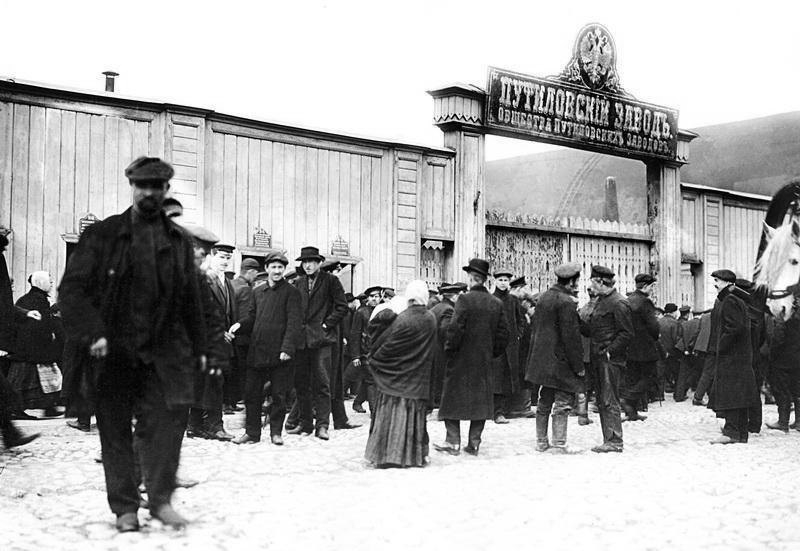
Putilov factory, Petrograd
Due to the large distances, by
assessment of German experts at the beginning of the war, Russian conscript had
overcome by an average 900-1000 km to your destination, whereas in the West
Europe, this figure averaged 200-300 km. At the same time in Germany
100 km² had 10,1 km of railways, in France - 8,8, at
Russia - 1,1; Besides, three-quarters of Russian railways were
one-track.
According to calculations of the German
Schlieffen plan, Russia will hold a mobilization, in view of these difficulties for 110
days, while Germany - just 15 days. These calculations were well
known and most Russian, and French allies; France has agreed
to finance the modernization of the Russian railway communication with the front.
Besides, at 1912 , Russia to take more military program, which should
It was to reduce the term to mobilize 18 days. By the beginning of the war a lot of it yet
not been implemented.
FROM
the beginning of the war, Germany blocked the Baltic Sea, and Turkey - chernomorskie
straits. The major ports for import of ammunition and strategic raw materials became
Arkhangelsk, freezing from November to March, and ice-free Murmansk, on 1914
year still had no rail link to the central regions. The third
the importance of the port, Vladivostok, too remote. The result is, what
in the warehouses of the three ports to 1917 year stuck significant amount
military imports. One of the Meeting of measures to defend the country began reworking
Arkhangelsk narrow-gauge railway - the usual Vologda, which allowed
increased transportation three times. Also, construction of the railway started
to Murmansk, but it was only finished by January 1917 of the year.
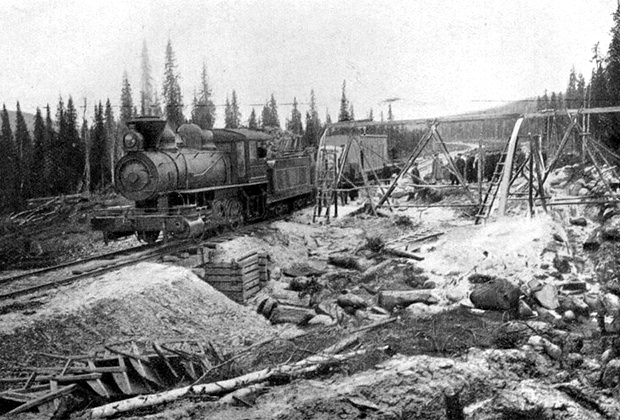
The construction of the Murmansk Railway, 1916 g.
Since the beginning of the war the government
drafted into the army a considerable number of reservists, which were kept in the rear
on the training. Serious mistake was, that in order to save three
quarter reservists were deployed in cities, in the arrangement of parts,
the completion of which they were to be. AT 1916 he was held call
older age category, who consider themselves not to be apprehended and mobilization
order very Diseases. In one only Petrograd and its suburbs was taken
to 340 thousand. soldiers of spare parts and units. They were located in
overcrowded barracks, next to the civilian population, bitchy
the hardships of wartime. In Petrograd 160 thousand. men lived in barracks,
designed to 20 thousand. While in St. Petersburg, there were only 3,5 thousand.
policemen and several companies of Cossacks.
Already
in February 1914 the former Minister of Internal Affairs II. n. Durnovo submits
Emperor analytical note, which states, "In case of failure,
the possibility that in the fight against such an enemy, Germany, one can not
foresee, social revolution in its most extreme manifestations, we
unavoidable. As already mentioned, starts from the, that all failures will
attributed to the government. The legislative institutions begin violently against
his campaign, as a result of which the country will begin a revolutionary
performances. The latter immediately nominated socialist slogans,
only, which can pick up and grouped the general population:
first black repartition, Whereupon a general section and all the values and assets.
defeated army, having lost to the same during the war the most reliable
personnel among its members, covered by a greater part of it spontaneously shared
peasants' desire for land, is too demoralized, that
serve as a bulwark of law and order. Legislative institutions and deprived
the real authority in the eyes of the oppositional intelligentsia Party people
be unable to contain costs folk wave, they also raised, and
Russia will be plunged into hopeless anarchy, the outcome of which defies even
predvideniyu ».
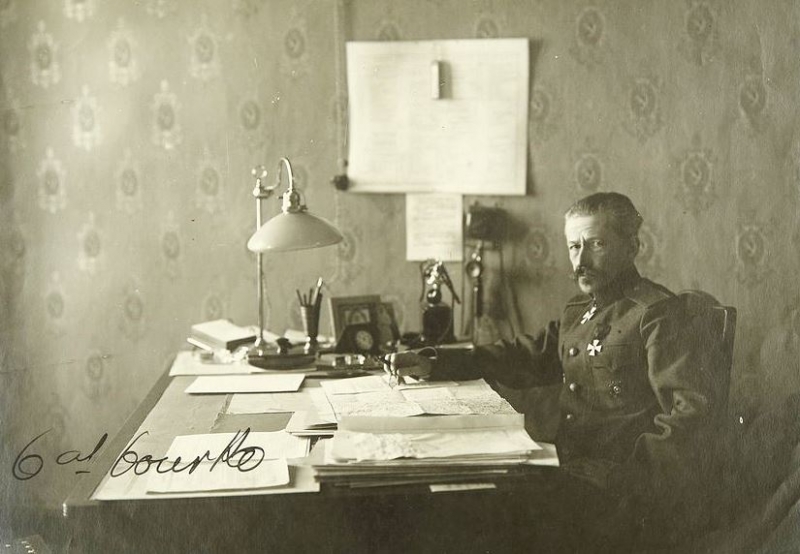
General VI. Gurko, 1916-1917 gg.
For winter 1916-1917 s palsy
Moscow and Petrograd supplies reached the apogee: they received only a third
necessary bread, and Petrograd, moreover - only half the required fuel.
Chairman of the Council of Ministers proposed in Sturmer 1916 year project of evacuation
Petrograd 80 thousand. soldiers and 20 thousand. refugees, but this project has not been implemented.
By the beginning of World War I.
changed the composition of the body. He began to include only two instead of three infantry
division, and equestrian Cossack regiment became established in time of war is no longer at
each infantry division, and when the housing.
in winter
1915-1916 General Gurko's reorganized military forces along the same
principle, that the year before Germany, and then France. Only the Germans and
French in the divisions was on 3 a shelf, and in the Russian left on 4, but the benches
translated from 4 on 3 battalion, and the cavalry - with 6 on 4 squadron. it
can reduce the accumulation of fighters at the forefront, reduce their losses. A
striking power divisions persisted, because they had the same amount of
artillery, and the number of machine-gun mouth and their composition increased, guns in the
connection becomes three times more.

General A.A. Brusiliv (third from right) the Council Supreme Headquarters, 1 April 1916 g.
From the memoirs of A. Brussiloff: "This
just my front were given a relatively significant funds for the attack
the enemy: the so-called Thaon - the main artillery reserve of the Supreme
Commander in Chief, which consisted of heavy artillery of various calibers, and two
army corps of that provision were to arrive in early spring. I fully
was sure, that at the same thorough preparation, which was conducted in the previous
year, and significant funds, who dispensed, we could not have in
1917 It was a good success. Troops, as I said above, had solid
frame of mind, and they could hope, with the exception of the 7th Siberian
housing, who arrived at my front in the fall of Riga district and was
fluctuating mood. Some disorganization made an unsuccessful measure
the formation of the Third Division in buildings without difficulty and artillery form
transports these divisions due to lack of horses, and partly forage. doubtful
it was also a condition of the horse in general composition, because oats and hay delivered
from the rear are very few, and the place was not possible to get anything, So
as already all been eaten. The first to break through the enemy fortified zone, we,
certainly, could, but further westward with a deficiency and weakness
horse composition make dubious, what I reported to, and urged
rapidly help this scourge. But at GHQ, which I have already returned Alekseev (Gurko
again I took special army), as well as in St. Petersburg was, obviously, no up-front.
Preparing great events, overturned the entire way of life and Russian
destroyed and the army, which was at the front.
in
the February Revolution, the day before the abdication of the last Russian
Nicholas II Emperor, Petrograd Soviet issued a decree №1, abolishing the principle of
unity of command in the army and to establish the soldiers' committees in the army and
courts. This accelerated the moral disintegration of the army, reduced its combat capability and
contributed to the growth of desertion. "
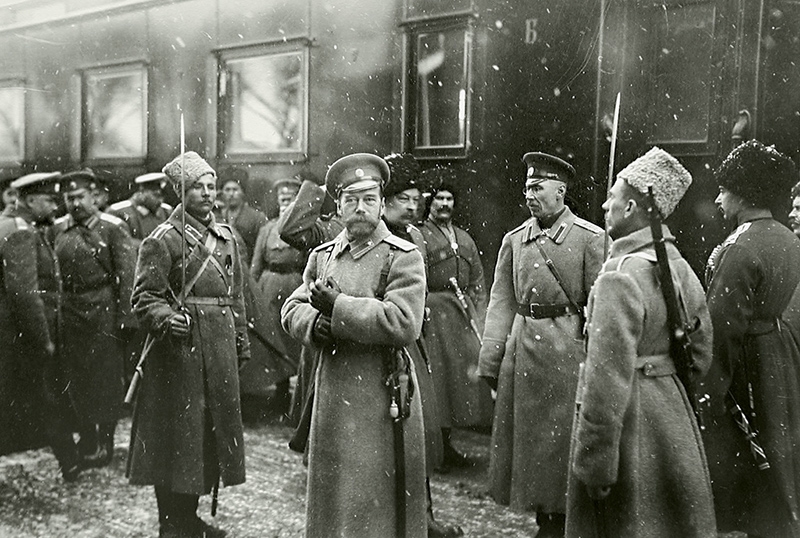
Nicholas II Emperor, February 1917 g.
Ammunition for the upcoming
offensive was harvested as, that even with a complete halt of all
Russian plants would be enough for 3 months of continuous battle. However, can
recall, that the weapons and ammunition, accumulated to this campaign, then enough
for all civil, and still have a surplus, which 1921 the Bolsheviks
gave Turkey Kemal Pasha. AT 1917 prepared by the introduction of a new army
uniforms, more comfortable and at the same time made in the Russian national
spirit, what it should have been further raise patriotic sentiments. This
form was produced by the famous artist sketches Vasnetsov - for soldiers
instead peaked caps were provided cloth shapki- "bogatyrki" (they
most, which later would be called "Budenovka"), beautiful overcoat with a "talking",
reminiscent of a musketeer coats. For officers sewed lightweight and practical
Kozhanka (they, which will soon be flaunting commissioners and security officers).
TO
October 1917 , the strength of the army reached 10 million people, although at the front
was only about 20 % its total. During the war it was mobilized
19 million people - nearly half of the men of military age. The war began
the hardest test for the army. By the time of the Russian war losses
killed over three million.
Gabriel Tsobehiya











